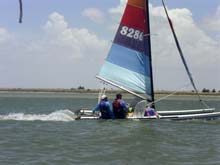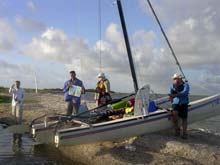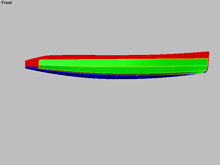I have two sailboats and a very limited boating budget. My Ulua is home built and my Hobie 18 is a Craigslist steal at 600 bucks. I love taking camping trips each summer and have usually taken kayak trips with my wife or my buddies Brian and Jason. I read about the Texas 200 and convinced Brian to join me even though his sailing experience was limited to renting a Hobie Wave and sailing my H18 once before we took the trip to South Texas. I thought about bringing my Ulua, but was worried that it wouldn’t take the weight of two guys, camping equipment, and fresh water.
 |
As you can see it’s got about 12” of freeboard with just me aboard. Add camping gear, food, water, and a passenger, and it wouldn’t have been the right boat.
click images to enlarge |
I had built Dierking's Ulua at 21' because it's versatile and beautiful. Mine is in his book as a tri, but currently rigged as a single outrigger with a different set of beams. I also have his plans for Tamanu. Cool boats! I also like cats, and I would love to have a cruiser at 21-22'. I thought about making a second Ulua on the same moulds, but the 18" freeboard is a bit short. I could raise it to 24" and deck the boat, but then it's not a Ulua or a Hawaiian outrigger canoe. His Tamanu design fits the bill with a higher freeboard, decked hull, and self-bailing footwells. Qualities I want in my next sailboat include being easily reefable, having a hard deck, comfortable seating, huge tent on deck when shore looks unappealing, etc. The additional length over the Hobie 18 is for fine hulls that can still take the weight I'm looking to carry (4 adults plus lunch or 2 plus cruising gear). Think about 1000# at the upper end without dragging the transoms. With a canoe stern like Tamanu's I suppose the draggy stern issue goes away, but it does limit where the deck goes. I'd like to add my two horse Merc to the mix as paddling a bigger double canoe is best done for short distances or with larger crews.
Here Gary and his wife come back to shore after a productive day fishing in Fiji. Note the additional freeboard. It also comes in a decked version. |
 |
I could alternately cut the decks off of a P19 or similar and add freeboard while either reducing sail (from the foot too to give some headroom under the boom) or add an easily reefed rig to control speed and add safety.
Building from scratch might be the best alternative, as Mike Lenenman has designed the exact boat I’m looking for in the Beachcat 22.
 |
Here’s a rendering of Mike Lenenman’s Beach cruiser 22. It has most of what I would want in a quick to launch beach cruiser. |
However, I couldn’t build either boat on my limited budget and even more limited time table prior to going. I had about 6 months, but these things take longer than expected. I was thinking of using the new to me H 18 but was unsure about how it would perform. A seasoned beachcat sailor (Thanks Buzz!) emailed me and told me to take it exactly as it was after inspecting it and making any needed repairs.
That said the H 18 worked well for the Texas 200. We were first to get to the sites most days or nearly so on elapsed sailing time. The sailing was fun if a bit wetter than I would want to be for any sustained period of time. The boat carried the weight, but not well. The reefing was accomplished by roller furling jib and a serious twist in the head of the sail. We carried all camping equipment needed for the five day event + food and water.
| Brian helming. Nice roostertails but note the 6" of freeboard aft |
 |
 |
Here’s the H 18 on Paul’s Mott camp site. |
Refining the boat choice would be a personal thing, but for me would include:
- More length--more carrying capacity
- More hull width--same reason
- Greater freeboard--dryer ride and less slapping of the deck or tramp.
- Hard deck to camp on at places like Camp 1 rather than slog through the mud--but the site was awesome once there!
- Slab reefing. Roller furling the jib results in weather helm. Duh. Just when you need a neutral helm with wind and waves up, you get to pull even harder!
- Bigger hatches. We stuck stuff through the 5" ports and lashed stuff to the front crossbar. Low and secure is better. Easily accessed is better still.
- More comfortable seating. Camp seats for 4+ hours a day is not as fun as it looks zooming by at 10 knots. Getting my heels below my butt even a little would make a huge improvement as would using a cushion with a bit more give--and one that is attached to the boat. I lost both camp chairs that week.
- A bimini might be cool literally as well, but long pants, a long sleeve shirt, a hat, and sunscreen worked for me.
- Keep the speed and stability advantage of catamarans without the ragged edge performance of a beachcat. A more sensible SA/D is a good place to start.
Even without the ideal boat for me, the T200 was a fantastic experience and helped me clarify what kind of boat is best for my family and me. I love being able to sail at a moment’s notice and long setup times at the ramp are not ideal for anyone. My father in law has a Hobie Wave that I can assemble in about 30 minutes, but even that is more than I would like to spend. That eliminates trimarans for me even though they are a really slick ride. Mike Leneman’s L7, smaller Beach Tri 22, and Chris Ostlind’s tri’s are close, but the time at the ramp is critical for me. That leaves catamarans for my preferred sailing style. At 21-22’ the ideal beam might be something approaching 11.5’—but trailering something like that might be a bit of a challenge. Rather than go with the ideal ratio for cats, making the rig less powerful and of a legally trailerable beam seems like a better alternative than making the assembly time any longer than stepping the rig and raising sail. This length will fit in the garage, trailer within legal limits without special permits, and still make a sizable platform for daysailing with 4 and cruising with 2. Nothing has begun at this point, but refining my desires and nailing down the design goals are the first steps.
I’ve been corresponding with Chris Ostlind ever since trying to go with a more powerful rig on my Ulua. He came up with a great solution in the Cardiff 21 that allowed me to reuse beams, tramps, and mainsail. It’s beautiful and nearly perfect except for time at the ramp. This has become an overriding consideration for me as is speedy cruising. Getting the Hobie 18 also changed what I wanted as well. Correcting its shortcomings will allow a neat little cat daysailor and cruiser. Chris has created a few renderings that really get the idea.
This rendering gives a size idea of just how big the Neo is compared to the H 18. |
 |
Dan
*****
More Articles by Dan St Gean:
|

